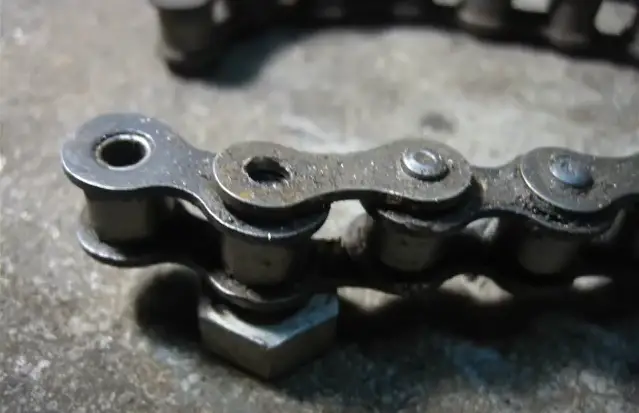Having a broken bike chain can be infuriating, and it is even more confusing when this happens with a new chain, making you question what caused the problem. When your bike chain breaks without warning, the question naturally arises: “Why did my new bike chain break?” You would expect a new chain to be strong and trusty, so it is confusing that it breaks so early. A number of reasons could be to blame for this issue, from improper installation to manufacturing defects or even environmental issues like weather or soil conditions.
In this article, we shall mention the common cause of a broken new bike chain and how to avert it from happening in the future.
2. Understanding the Purpose of the Bike Chain
To know why your new chain on your bike might break, let’s begin by knowing the important role a bike chain plays in the overall movement of your bike. The chain is an important part of the drivetrain system and its role is to transmit energy from your pedals to the wheels. It works in combination with the gears, derailleurs, and cassette to regulate your pedaling speed and allow smooth movement.
If your chain doesn’t function properly, your bike will not run properly, and it will be hard to pedal smoothly. Smooth pedaling depends on the toughness of the chain, and if it wears out, the overall riding experience is compromised.
3. Reasons Why a New Bike Chain Breaks
While bike chains are made to last, there are several reasons that might cause the chain to break even if it’s brand new. Below are some common reasons that might be responsible for the sudden breakdown of a new chain:
Manufacturing Defects
One of the probable causes is a manufacturing defect, where the chain isn’t built to sustain the stress it is put under when being used every day. Flaws such as weak links, poor-quality materials, or improper assembly in factory manufacturing may be involved. If your chain has a manufacturing defect, it will probably break sooner than expected despite the little use.
Improper Installation
If your recently fitted chain was not installed correctly, it could lead to higher wear or premature breaking. Incorrect installation could lead to improper tension on the chain, or misalignment of the chain to gears. A misaligned chain could also get stuck on the derailleur, leading to stress and breaking.
Poor Quality Chain
Chains made of lower quality materials or shoddily built may be susceptible to breaking. Cheap chains might not support forces acting upon them while cycling, especially for heavier loads or faster speeds.
Chain Length Problems
A chain that is too short or too long can lead to insufficient tension, causing too much tension on the links and they collapse. If the chain is too long, it sags, leading to missed gears and putting unnecessary stress on some links. If it is too short, it is too tight, leading to tension and a point of breakage.
4. External Conditions That Can Cause a Broken Bike Chain
There are external factors such as riding conditions and usage patterns of the bike that can also lead to breaking a new chain. These conditions can put a lot of stress on your chain and make it wear off faster.
Harsh Riding Conditions
Frequent use on rough, bumpy roads is extremely stressful to the chain and causes it damage. Harsh roads, downhill travel, and mountain biking subject extra stress, causing the chain to stretch or break. The chain should be checked regularly after hard rides for wear.
Overuse
Overuse of the bike without servicing or with too many gear changes will lead to wear and tear over time. Riding the bike at its capacity without regular checks will lead to the chain losing tension and power at its best. Overuse will also lead to the chain wearing out faster if not serviced well.
Weather and Environmental Factors
Extreme weather conditions, such as persistent rain or snow, can cause the chain to rust and make it weak even if it is new. Water gets into the chain links, encouraging corrosion, which destroys its structure. Riding in wet conditions without cleaning the chain afterwards accelerates rust formation, making it more likely to break.
5. Preventing Your New Bike Chain from Breaking
Taking preventative action can greatly lower the likelihood of your new bike chain breaking. Properly following maintenance processes and ensuring you pay close attention to installation can assist you in maximizing your chain’s lifespan without compromising it with sudden breakage.
Regular Maintenance
Regular maintenance of your bike and chain, like lubricating and cleaning the chain, will assist in ensuring the longevity of your chain. A dirty or dry chain tends to wear out faster and break. Cleaning the chain after every ride and lubricating to lower friction keeps the chain in its best shape.
Proper Installation
Ensure the chain is installed correctly and tension is right to avoid unnecessary stress. The chain would not engage the gears correctly if poorly installed, putting stress on individual links. Refer to your owner’s manual or consult an expert to ensure that the chain is correctly installed.
Choosing the Right Chain
Selecting a high-quality chain that can resist the wear and tear without wearing down too soon is essential to prevent surprise breakage. Not every bike chain is the same. Select a chain that’s designed according to your bike model, be it mountain biking, road cycling, or for hybrid use, to ensure it’s strong enough for your cycling.
6. What to Do if Your New Bike Chain Breaks
If your new bike chain breaks unexpectedly, here’s what you can do to repair it and avoid future problems. As frustrating as it might be, doing the right thing can get you back on the road fast.
Step-by-Step Guide to Fixing a Broken Bike Chain
Witness this simple step-by-step repair process for your broken bike chain and ride safely again as early as possible. Start with the use of a chain tool to cut the broken link and cut the chain. If the chain is fixable, reconnect the link and tighten the chain. Or, you may need a new link or a full replacement chain, depending on the damage.
Locate the Break
- Inspect the bike chain to locate where the break has occurred. If the chain is completely disconnected, this is easy to spot. If it’s just a snapped pin, you may need to look carefully to find the damaged section.
Remove the Chain from the Bike
- If your chain is still on the bike, use the chain tool to remove it from the derailleur and gears.
- Once removed, you can take the chain off the bike for a more thorough inspection and repair.
Use the Chain Tool to Remove the Broken Link
- Insert the broken link of the chain into the chain tool.
- Use the chain tool to push out the broken pin. Be careful to avoid damaging the rest of the chain when removing the pin.
- If the chain is broken in more than one place, remove each damaged section by repeating this step.
Clean the Chain (Optional)
- Before repairing or replacing the link, it’s a good idea to clean the chain of any dirt, grease, or debris using a rag or chain cleaner.
- This ensures that no foreign particles interfere with the smooth operation of the chain after repair.
Reconnect the Link (If Possible)
- If only one link is damaged, you may be able to reassemble the chain with a new pin or quick link.
Once the two ends of the chain are aligned, use the chain tool to reconnect with a quick link or push a new pin. Make sure the new pin is fully inserted to avoid future breakage.
Install a New Link (If Needed)
- If the chain is damaged beyond simple repair, you may need to add a new link or a replacement chain.
- Use a new, compatible chain link or a quick link, then follow the same process as above to reconnect the chain.
Test the Chain
- Once you’ve reconnected or replaced the chain, carefully reinstall it back onto your bike. Turn the pedals manually to check if the chain is moving smoothly without any snags or skips. Test the shifting if applicable.
Tighten the Chain
- If your chain has become loose after repairing, use the derailleur to adjust the chain’s tension. This will ensure the chain operates at the right tightness for proper functioning.
- If needed, adjust the length of the chain by removing or adding a link, depending on your bike’s setup.
Test Ride Your Bike
- After everything is tightened and appears to be in order, test ride your bike briefly to make surethat the chain is functioning properly and smoothly.
- Listen for any strange noises, and pay attention to the shifting performance.
When to Replace the Chain
If the chain is non-repairable, the best option could be to swap it for a new one. Examine the chain for excessive wear, rust, or stretched links. If the chain is too damaged, using it can further harm the gears and derailleur of the bicycle, which will be more expensive to fix in the future.
FAQ’s
1. What are the common reasons for a new bike chain breaking?
A new bike chain can break due to manufacturing defects, improper installation, poor quality materials, incorrect chain length, or harsh riding conditions.
2. Can I fix a broken bike chain myself?
Yes, you can fix a broken bike chain yourself with the right tools, such as a chain tool, and following a simple guide. However, if the damage is extensive, you may need to replace the chain.
3. Is it normal for a new bike chain to break?
No, it’s not normal for a new bike chain to break unless there’s a defect or it’s subjected to extreme conditions or improper use.
Conclusion
Understanding the possible reasons behind a broken bike chain enables you to avoid such incidents in the future and provides a smoother ride. Whether due to improper installation, external factors like weather or terrain, or manufacturing defects, understanding what to check for may prolong the life of your bike chain.
The keys to prolonging the life of your bike chain are proper installation, routine maintenance, and chain selection. Through these guidelines, you can avoid the trouble of unexpected chain breakage and keep your bike in its best performance.

I am Ryan Ford, a mountain biking enthusiast who loves to explore the outdoors. I also like to go on adventures with friends and anything else that involves being outside. I love my bike because it gets me out of the house and gives me an opportunity to enjoy nature.

